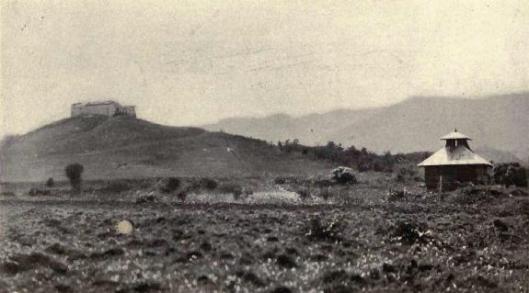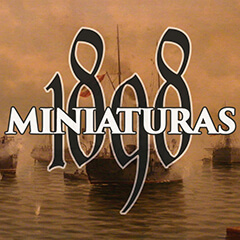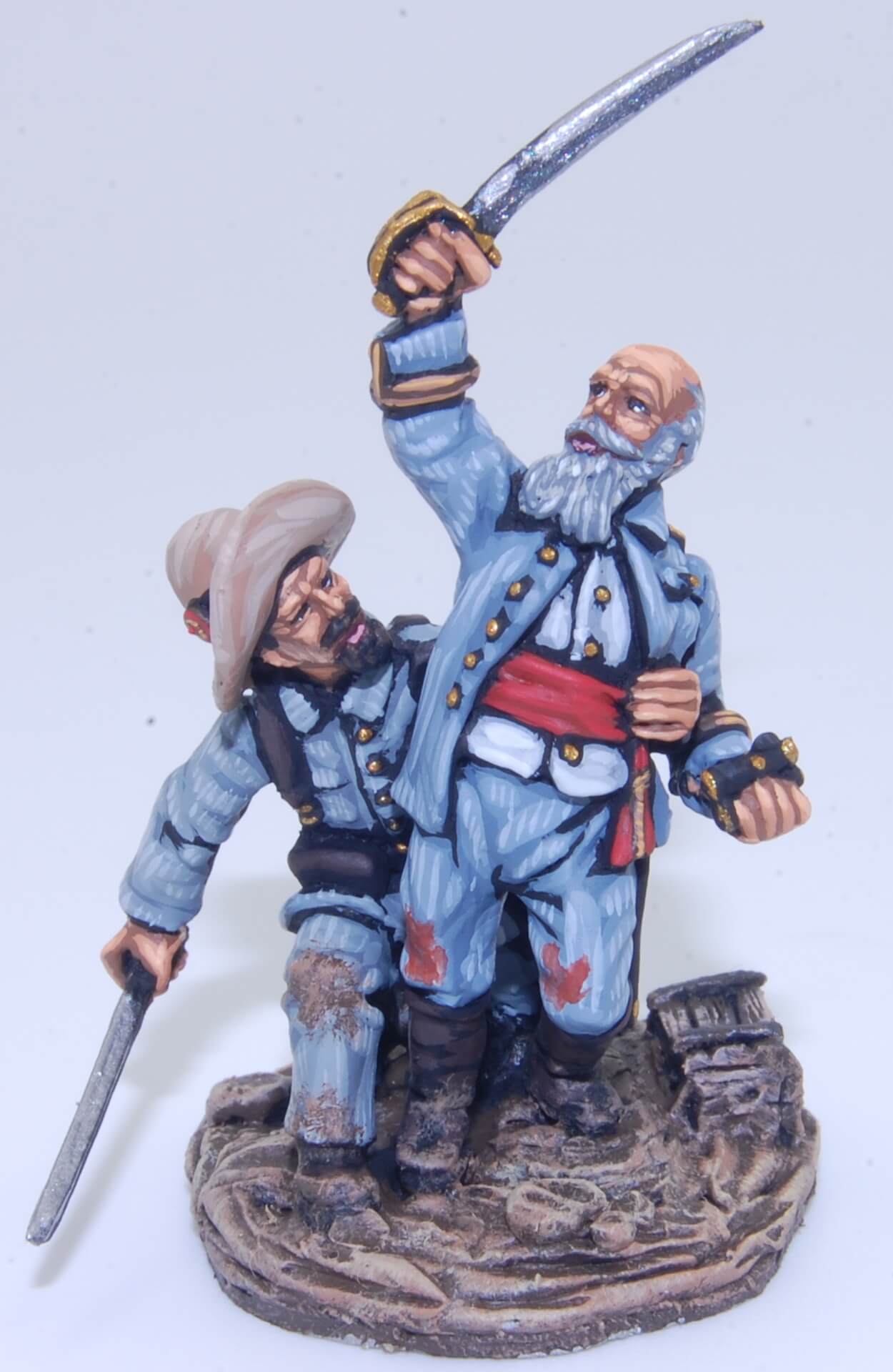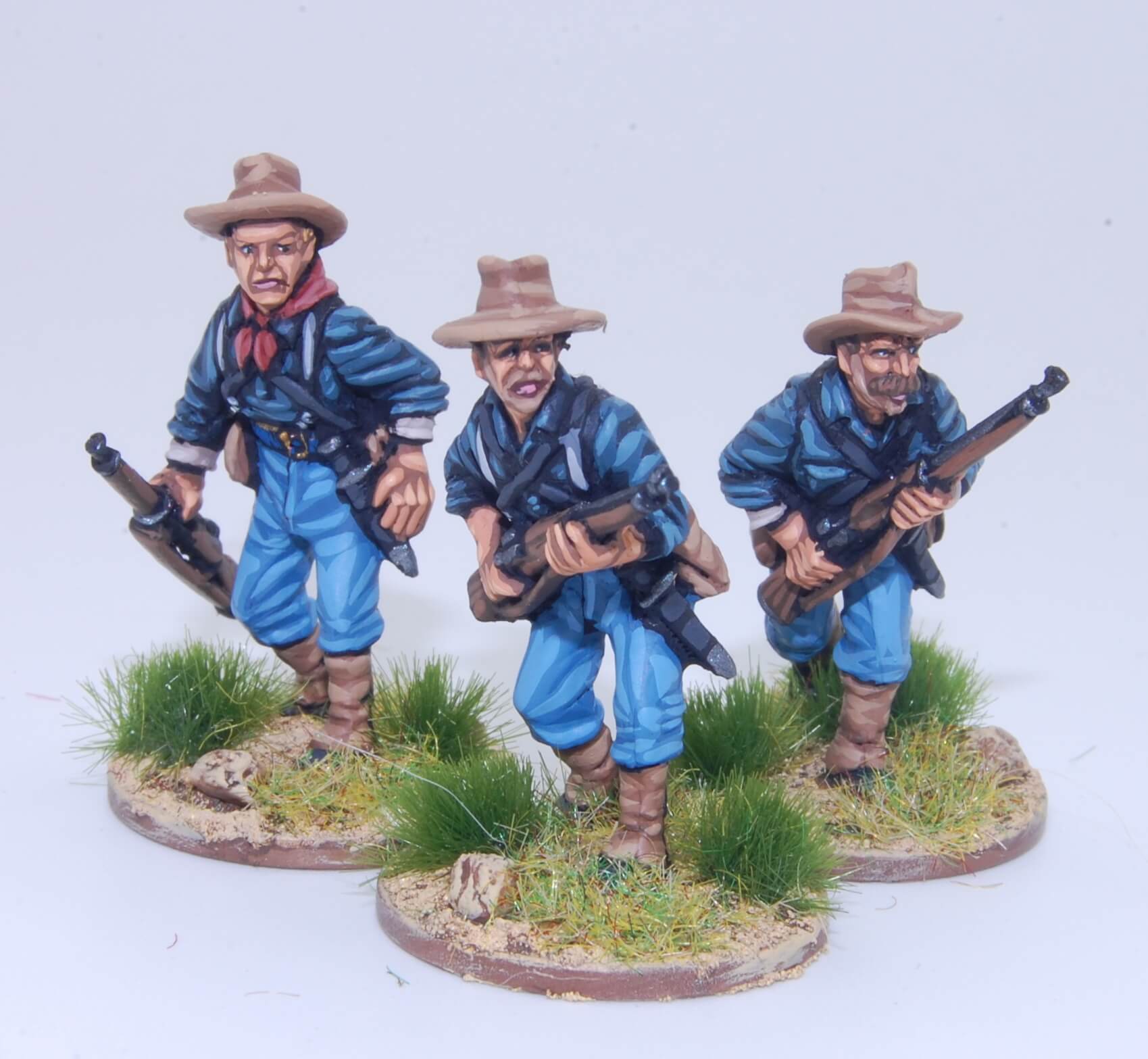Joaquín Vara de Rey and the battle of El Caney
Frank Jastrzembski
www.frankjastrzembski.com

Joaquín Vara de Rey and the battle of El Caney
“When the American army attacked El Caney they had not counted on a general of Vara de Rey’s stamp and on troops as fiery and insured to warfare as those he had under his command.”
General Arsenio Linares y Pombo
After nearly nine hours of uninterrupted fighting and a loss of over eighty percent casualties, General Joaquín Vara de Rey y Rubio had no choice but to order his Spanish infantrymen to abandon their defensive works at El Caney. There was no shame in the orders for evacuation; the 520 Spanish regulars and guerillas of his command fought like lions and bloodied an overwhelming American division of 6,500 men under the command of the Civil War veteran, General Henry W. Lawton. The presumptuous American general had underestimated the tenacity of these defenders, only anticipating minor, if any, resistance on his march to reinforce the American assault on San Juan Heights. This was in large part due to the man directing the Spanish defenses.
The stubbornness of the defenders and gallantry of the 57 year-old General Joaquín Vara de Rey y Rubio were unrivaled by any other Spanish body of troops or leader in Cuba during the Spanish-American War. The general recklessly exposed himself, appearing invincible to enemy bullets, in order to calm and motivate his men to remain fixed in their desperate positions. His plain grey uniform decorated with gold trim, large straw hat, and colossal white beard set against the brown and green landscape, made him a conspicuous target for the American Springfields and Krags. Americans, Spaniards, and Cubans present that day would have surely agree with the assessment of one witness who declared that the general possessed “a heart of a lion” during the engagement.
Only seconds after General Vara de Rey y Rubio issued orders to abandon El Caney and retreat to Santiago, two bullets smashed into his legs almost simultaneously. The general crashed to the ground in agony, and an aid rushed over and ordered four soldiers to load the general onto a canvas stretcher. As he lay severely wounded and deafened by the sounds of battle, one has to wonder if Vara de Rey y Rubio found peace in knowing that he helped to undermine the American offensive on the San Juan Heights and that his men’s performance on that day was arguably the most admirable display of fortitude by Spanish soldiers during the whole war.
The Man Behind the Defense
Joaquín Vara de Rey y Rubio was born in 1840 on the Mediterranean rock island of Ibiza, a member of the Balearic Islands, located off the coast of mainland Spain. At the age of 15 years-old, he entered the Colegio General, and upon graduation, entered the Spanish Army with the rank of second lieutenant. In 1872, he fought in the ruthless Third Carlist Civil War that tore Spain apart for four years. He received a transfer to the Philippines in 1884, rising to the rank of lieutenant colonel. He then served as the forty-first governor of the Mariana Islands from April 1890 to August 1891, situated in the Pacific Ocean.
He was no stranger to internal struggles when he requested a transfer to Cuba in 1895. His most praiseworthy achievement leading up to El Caney came when he led a regiment in the assault of a Cuban rebel stronghold on the Loma de Gato Hill on 5 July 1896. During the six-hour engagement, his command suffered heavy losses, losing eighty killed and 160 wounded. The rebels suffered the loss of ten killed and between forty and fifty wounded, most notably José Maceo, brother of Antonio Maceo, the famed guerilla leader and the second-in-command of the Cuban Liberation Army. The battle may have been regarded as a defeat had it not led to the death of Maceo. For his success in killing the rebel leader, Vara de Rey y Rubio was promoted to a brigadier general and awarded command of the San Luis Brigade.

El Caney: Cuba’s Thermopylae
One 1 July 1898, Lawton’s American division of 6,500 men of the Fifth Corps (roughly half of the lethargic and ungainly General William R. Shafter’s command) approached the small village of El Caney, located five miles northeast of Santiago. The village and surrounded hills, turned into an imposing defensive structure by the Spanish, secured a strategic approach to Santiago. The actual village was composed of only a few fragile stone buildings and roughly the same number of streets. The garrison of El Caney was composed of three companies of regulars of the First Battalion of the Twenty-Ninth Regiment (Regiment of the Constitution), forty men of the Santiago Regiment, and one company of dismounted guerrillas with two breech-loading Plasencia guns – 520 men all under the direct command of Vara de Rey y Rubio.
Though hopelessly outmatched, Vara de Rey y Rubio’s defensive position was one of the greatest obstacles the Americans encountered since landing in Cuba. The position was anchored by an old stone fort known as El Viso, located near the extreme right of the village at an elevation of 100 feet. One soldier noted that it sat on top of the hill like a “crater of a volcano,” and claimed it was “impregnable to military assault.”

Loopholes were cut in the village’s buildings to provide a sheltered for Spanish soldiers to fire. Six timber blockhouses, a string of barb wire fences, and zigzagging lines of trenches roughly fifty yards in length and deep enough to conceal a man up to his shoulders, interconnected the position.
Lawton arranged his three main brigades (Ludlow, Miles, and Chaffee) to encircle Vara de Rey y Rubio’s position and cut off their line of retreat to Santiago. He intended to launch a well-coordinated and cohesive assault on the Spanish stronghold once weakened by his artillery. The action commenced at sunrise at 6:30 am, when four guns of Battery “E” of the First United States Artillery unleashed a barrage of steel to shatter the defensive position before the general assault. Unfortunately for Lawton’s men, most of the shots hit the village rather than do damage any damage to the stone fort, trenches, or blockhouses.

The advancing lines of American infantrymen were hit with a wall of lead when the Spanish Mausers reigned down from their position at less than 1,000 yards. The lead American units suffered staggering casualties while moving over the open ground, one witness noting that they fell, “as though they were ears of corn severed from the stalks by the gigantic knife of an inexorable reaper.” Another observer stated that, “El Caney had been converted into a veritable volcano, vomiting forth lava and making it impossible to go near it.” Lawton soon realized that Vara de Rey y Rubio and the defenders would not easily budge. At one point in the action, Shafter ordered Lawton to break off the costly engagement, but Lawton reasoned that he was too heavily committed to withdraw – He may also have been aware that a Spanish victory would have led to a detrimental blow to American morale.
A lull in the battle allowed Vara de Rey y Rubio to reorganize his defensive line and make preparations for what would be the final and most vicious assault. No reinforcements came to help El Caney’s battered defenders, and ammunition was almost exhausted. The Americans surged forward in waves straight into the racking fire, one followed by the next, but the momentum was too much for the Spanish defenders, and their line began to buckle. The Americans were finally able to make use of their guns and start to pulverize the defenses, exploiting a breech in the Spanish position by rushing men from the Twelfth and Twenty-Fifth U.S. Infantry Regiments in the gap. Vara de Rey y Rubio ordered his men to abandon El Viso, and consolidate and reform near the interior of the village.

In the act of encouraging his men in this desperate point of the battle, Vara de Rey y Rubio went down with wounds through both of his legs. As he was being carried away by soldiers on a stretcher, a spray of bullets ripped into the party. A single bullet shredded the general’s skull, killing him instantly, while two of the stretcher bearers fell dead. The orderly retreat soon deteriorated into a rout, leading to the triumphant American occupation of El Caney.
Only eighty of the brave defenders (mostly wounded) trickled back into Santiago. The remainder had been killed or captured. Among the dead were Vara de Rey y Rubio’s two sons and nephew, while his brother was captured after being wounded. The Americans paid dearly for the assault; one American account regarded it as, “the hardest fought battle of the war.” Lawton’s command suffered the heavy loss of eighty-one killed and 360 wounded. Lawton ordered Vara de Rey y Rubio’s body to be buried in simple grave on the field of battle.

The Spanish Stonewall’s Legacy
Despite stereotyping Spanish soldiers and officers in Cuba as an inferior foe during the war, the Americans treated Vara de Rey y Rubio with respect for his bravery and spirted defense. Five months after his death, a party of Spanish officers returned to Cuba to retrieve the general’s body. The acting Military Governor of Cuba, American General Leonard Wood, met these officers upon their arrival and avowed that, “General Vara del Rey was a brave man, and we honor his memory,” promising to assistance any way he could in retrieving his remains. The Spanish excavation team had a hard time locating the body, at one point digging up mule bones though to be the general’s, until General Manuel Valderrama finally identified the body. As the casket rolled down the wood planks of the dock toward the steamer destined for Spain, Wool and his staff bowed their heads and removed their caps in a sign of respect to the deceased general.
Vara de Rey y Rubio was posthumously awarded the Laureate Cross of Saint Ferdinand, and a bronze statute was erected on the island of his birth depicting his death in battle. The ruins of El Viso can still be visited today, along with some waning monuments dedicated to the Spanish and American soldiers that fought and died in Cuba’s Thermopylae.

Further Reading
“El Caney.” Cuban Battlefields of the Spanish-Cuban-American War. University of Nebraska Center for Digital Research in the Humanities. http://cubanbattlefields.unl.edu/imagery/DSCN0345.php.
Chadwick, French E. The Relations of the United States and Spain: The Spanish-American War. Vol. 1. New York: Charles Scribner’s Sons, 1911.
Hall, Michael R. “Joaquín Vara de Rey y Rubio.” In The Encyclopedia of the Spanish-American and Philippine-American Wars, edited by Spencer Tucker. Vol 1. Santa Barbara, CA: ABC-CLIO, 2009.
“Honoring A Dead Foe: How the American Troops Sought Out and Buried the Spanish Hero of El Caney.” In Hero Tales of the American Soldier and Sailor, as Told by the Heroes Themselves and Their Comrades: The Unwritten History of American Chivalry, edited by James W. Buel, 304-306. Philadelphia, PA: Hero Publishing Company, 1899.
Miley, John D. In Cuba with Shafter. New York: Charles Scribner’s Sons, 1899.
Nofi, Albert A. The Spanish-American War: 1898. Conshohocken, PA: Combined Books, 1996.
Prego, Louis G. The Battles of San Juan and El Caney, Or, the Siege of Santiago. Santiago de Cuba: Imp. E. Beltran, 1911.
Report of the U.S.-Commission Appointed by the President to Investigate the Conduct of the War Department in the War with Spain. Washington: Government Printing Office, 1899.
Rogers, Robert F. Destiny’s Landfall: A History of Guam. Honolulu: University of Hawaii Press, 1995.
Wilson, Frederick T. “The Flag of El Caney.” Journal of the U.S. Cavalry Association 14 (July 1903-April 1904): 90-95.
Newspapers
Evening Star (Washington, D.C.). July 24, 1896.
Kansas Agitator (Kansas). April 7, 1899.
Rock Island Argus (Illinois). August 15, 1898.
The Hawaiian Gazette (Hawaii). August 7, 1896.
The Watchman and Southron (South Carolina). November 23, 1898.





